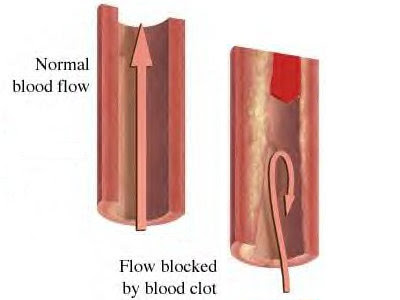

Damage to the brain can cause loss of speech, vision, or movement in an arm or a leg, depending on the part of the brain that is affected.
Stroke is the major form of cerebrovascular disease, or CVD, a term that sometimes is used interchangeably with stroke.
There are two main types of stroke:
Stroke caused by a blockage in the artery supplying blood to a particular region of the brain (called cerebral infarction). This is the most common type of stroke.
Stroke caused by bleeding within the brain (called intracerebral hemorrhage).
In addition, some people experience brief warning signals that a major stroke is going to happen in the future. The medical term to describe these symptoms is transient ischemic attack or TIA. Sometimes called "mini-strokes", TIAs are exactly like a stroke, but they last only a few minutes (or sometimes as long as an hour) and leave no disability.
In many cases, a stroke will affect only one side of the body:
A stroke that damages the right side of the brain will affect the left side of the body.
A stroke that damages the left side of the brain will affect the right side of the body.
1. Stroke Caused By Blocked Blood Flow 
About 85 percent of all strokes happen because not enough blood gets to the brain. Blood flow stops when an artery carrying blood to the brain becomes blocked. The technical name for this type of brain attack is cerebral infarction. It is also called ischemic stroke. "Ischemic" refers to a condition caused by a decreased supply of oxygenated blood to a body part.
The blockage can be caused either by a blood clot that forms in an artery in the brain, or by a blood clot formed elsewhere in the body that travels through the bloodstream to the brain. If this clot becomes stuck in an artery in the brain, a stroke can result.
Clots are more likely to form in arteries that are damaged by atherosclerosis , also called "hardening of the arteries," due to the buildup of cholesterol and other thick, rough, fatty deposits in the arteries. 
The blockage also can be caused by a small piece of tissue, usually a blood clot, that has traveled through the bloodstream from elsewhere in the body.
In ischemic stroke, one of two major arteries is usually involved:
The carotid artery (most commonly involved site)
The basilar artery
The carotid arteries start at the aorta (just above the heart) and lead up through the neck, around the windpipe, and into the brain. The basilar artery is formed at the base of the skull from the arteries that run up along the spine, and branches off in the brain.
2. Stroke Caused By Bleeding In The Brain 
The other 15 percent of strokes happen when an artery carrying blood to the brain bursts suddenly. The bursting can happen because of a weak spot in the wall of an artery called an aneurysm . This type of brain attack is called a hemorrhagic stroke.
Two kinds of stroke are caused by bleeding in the brain:
A subarachnoid hemorrhage occurs when a blood vessel on the brain bursts and bleeds into the fluid-filled space between the brain and the skull. This type of stroke can happen at any age.
An intracerebral hemorrhage occurs when an artery bursts inside the brain, flooding the surrounding brain tissue with blood. This type of stroke is often associated with high blood pressure.
What Are "Mini-Strokes"?
A "mini-stroke" is exactly like a stroke, but it lasts only a short time and leaves no disability. The term for this event is transient ischemic attack or TIA.
A TIA happens when a blood clot clogs an artery temporarily, cutting off blood flow and, consequently, the supply of oxygen to cells. But the difference between a TIA and a stroke is that, with TIA, the blood clot dissolves on its own and blood flow is restored before permanent damage to the brain can occur.
TIAs are an extremely important warning sign for stroke and should never be ignored.







